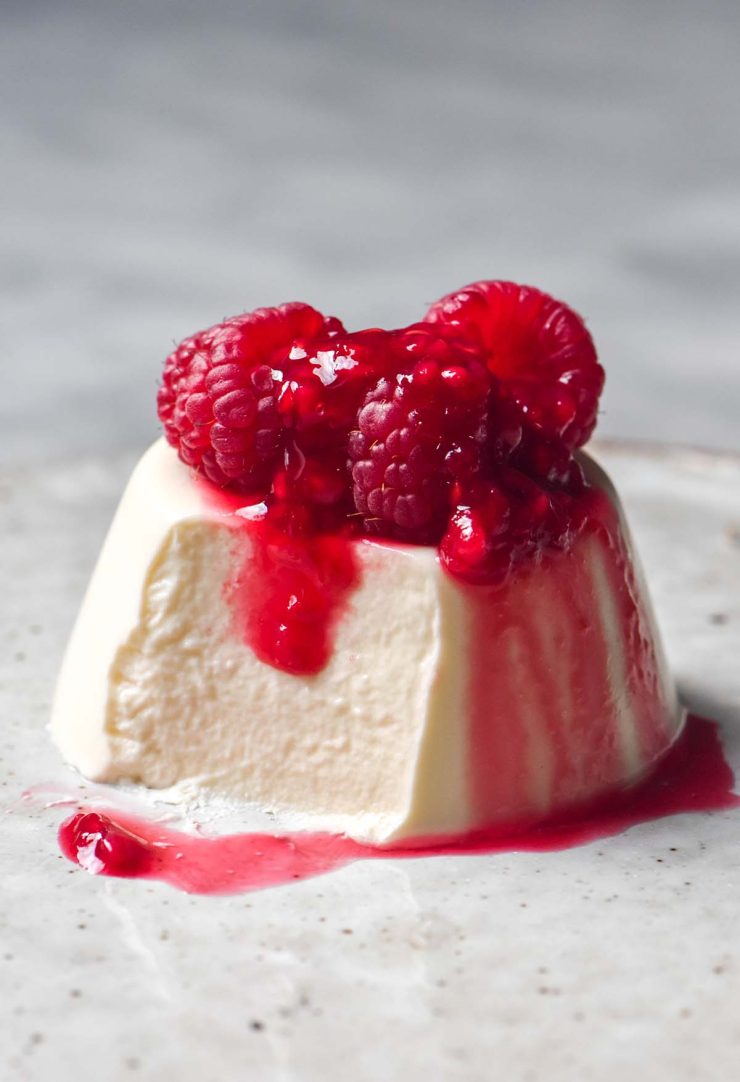
I have developed a few panna cotta recipes with agar agar at this point. We’ve got the classic panna cotta, white chocolate panna cotta and coconut panna cotta, to name a few. However, one thing I didn’t have was a good recipe for vegan panna cotta without coconut. I wanted to make sure those who are dairy free but with allergies or aversions to coconut can enjoy dessert too. Let’s get straight into it!
Vegan panna cotta without coconut
These vegan panna cotta require only 4 ingredients: agar agar powder, vegan cream, white sugar and vanilla extract or vanilla bean paste. We’re using water instead of vegan milk to create a neutrally flavoured yet creamy and rich panna cotta.
The panna cotta are vegan, dairy free, gluten free and nut free with the right vegan cream (more on this below). There is not a single whiff of coconut flavour either.
Notes on the vegan cream
I used Flora plant cream in this recipe. This isn’t sponsored, just genuine appreciation for a great product. The plant cream here in Australia contains 30g fat per 100ml. This is roughly on par with regular thickened cream, which is generally around 35g fat per 100ml.
The Australian version uses the following ingredients: ‘Lentil milk (water, lentil Protein (1%)), vegetable oils (coconut, canola),sugar, modified corn starch, emulsifiers (sunflower lecithin, sugar esters of fatty acids, mono and diglycerides of fatty acids), stabilisers (guar gum, locust bean gum), natural flavourings, salt, colour (beta-carotene).’
If you’re based overseas, use a vegan with similar ingredients and proportions to the above for best results. Although I haven’t tested the versions overseas, they do seem to be very similar to the variety sold here in Australia.
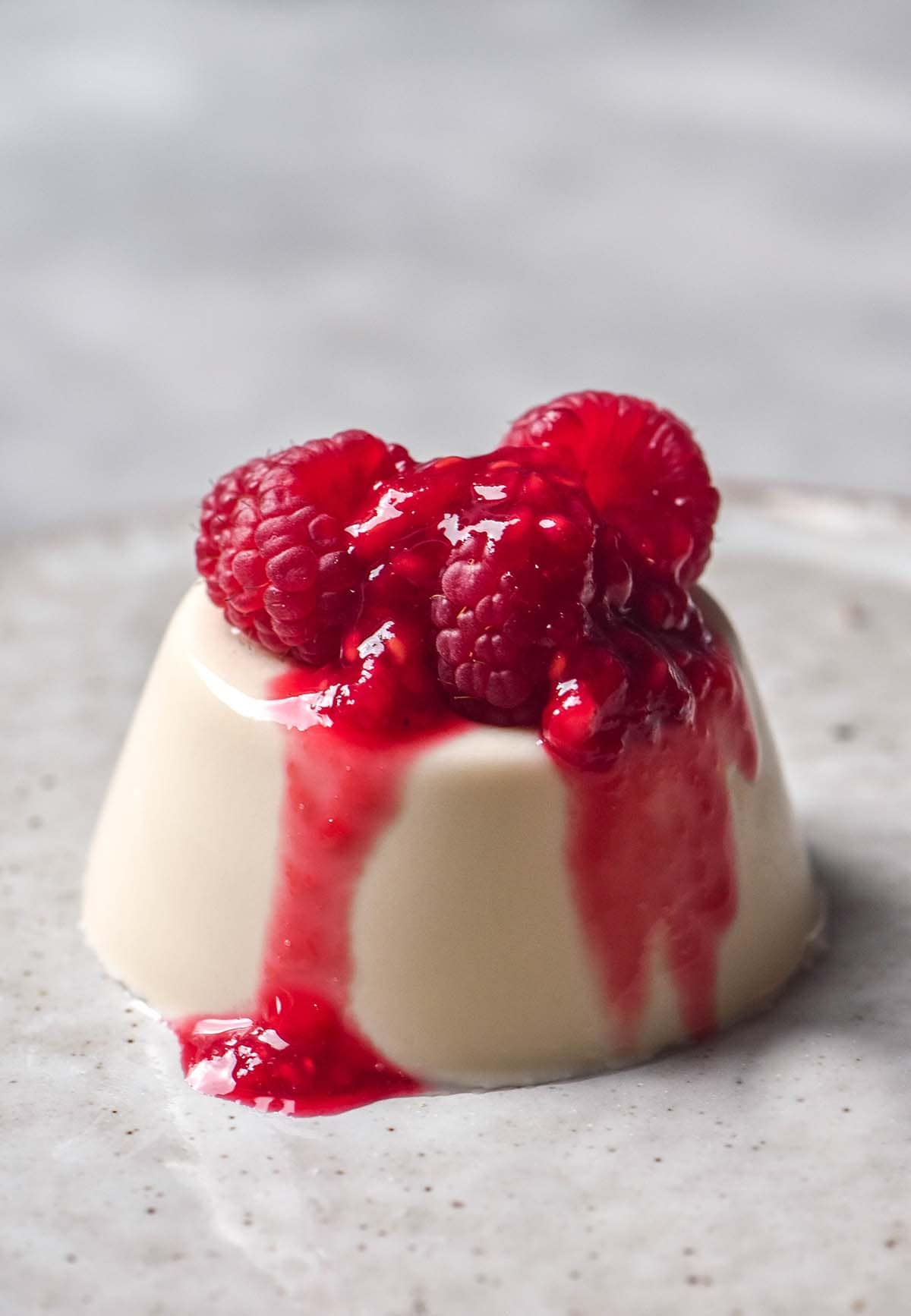
International readers
In the UK, there are two varieties of Flora plant cream – regular and double. You want to stay as close to 30g per 100ml fat as possible, so choose the double cream variety.
In researching, I came across Elmlea brand plant cream which also has a very similar ingredients list to Flora Plant cream. Make sure you choose the 100% plant cream version, though, as there seems to be a buttermilk version with a confusing name – ‘alternative to double cream.’
In America, it seems as though there is some Flora plant cream available in a limited capacity. However, it also appears that there is a variety from Country Crock that has similar ingredients to the Flora plant cream I used. It contains 30g fat per 100ml. I couldn’t tell if Canada has Country Crock or Flora plant cream available because their supermarkets have blocked international users from browsing.
I couldn’t find much information on the availability of vegan cream in Europe. Flora plant cream is made in Germany but I actually couldn’t determine whether it is available for sale there. I suspect that is to do with the fact that I live in Australia and I end up getting more local search results.
Either way, make sure your cream is at least 30% fat and has a similar ingredients list to the cream I have used. I can’t guarantee results that use something different.
Notes on the agar agar powder
Agar agar is a plant based gelatin derived from seaweed or algae. It performs in a similar way as gelatin, helping to set the panna cotta. It is mostly odourless and 100% tasteless in the finished product. There is no substitute – agar is a critical ingredient in this recipe.
Agar agar comes in powder, flakes or in strip form. I have never used the flakes or strips, so I cannot advise on how to use them here. I know they are not directly interchangeable in recipes, so I recommend buying the powder form. You can use it in a number of things, including my vegan low FODMAP mozzarella.
I have had mixed results with Gold Cup brand agar agar – sometimes it separates in a film of agar at the bottom of the panna cotta. I don’t know why this is or if I am using it incorrectly (the packet is in Thai). All this to say that if you are having a similar issue, it might be worth trying a different brand of agar.
I don’t know for sure, but I wonder if different brands of agar agar might have stronger gelling capacity than others, and perhaps I used too much.
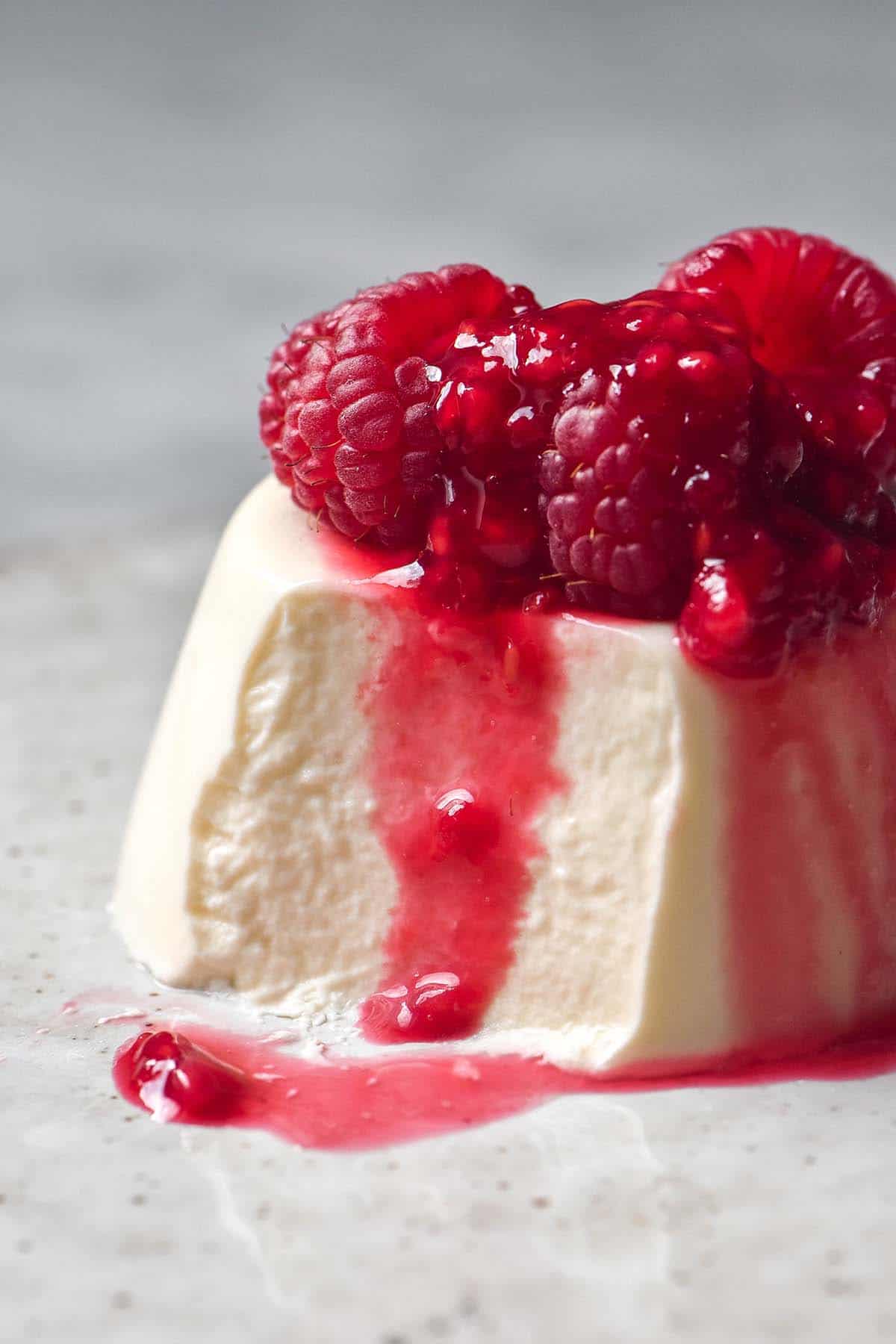
Tips on working with agar agar powder
I have tested recipes with agar agar many times now, so I have a lot to say about working with it. It is fairly straightforward, but it does have some quirks.
- Agar agar powder needs to be added to cold ingredients so it doesn’t clump up when it hits the liquid. For this recipe, I whisk the powder into the sugar and then pour in the water, followed by the vegan cream.
- It is really beneficial to allow the agar sufficient time to gel up on the heat. I found that allowing this panna cotta mixture to come to the boil over a low-medium heat was the best method to get it to gel.
- Really take your time with bringing the mixture to a simmer for a foolproof set.
- Agar that has not had enough liquid added tends to taste a bit gritty. That shouldn’t be an issue here, but I thought it was worth mentioning if you intend to experiment.
- Lots of recipes online tend to use quite a bit of agar agar compared to my recipe. I find that less is more when it comes to agar agar. Using more results in quite a firm set panna cotta that doesn’t melt in your mouth like the original does.
- Because we’re using less agar agar, we need to be patient. Allow it to cook over a low medium heat until boiling for best results.
- The tricky part about using agar agar is that there aren’t too many obvious signs that the mixture is ready to set. My best advice is to slowly get it to boiling point and then keep it there for 2-3 minutes or so.
- The best part about agar agar is that you can boil it again if something is amiss. In one test, my panna cotta had not set in the fridge after 3 hours. I simply reboiled the liquid and returned it to the silicone muffin tin and it set up almost instantly.
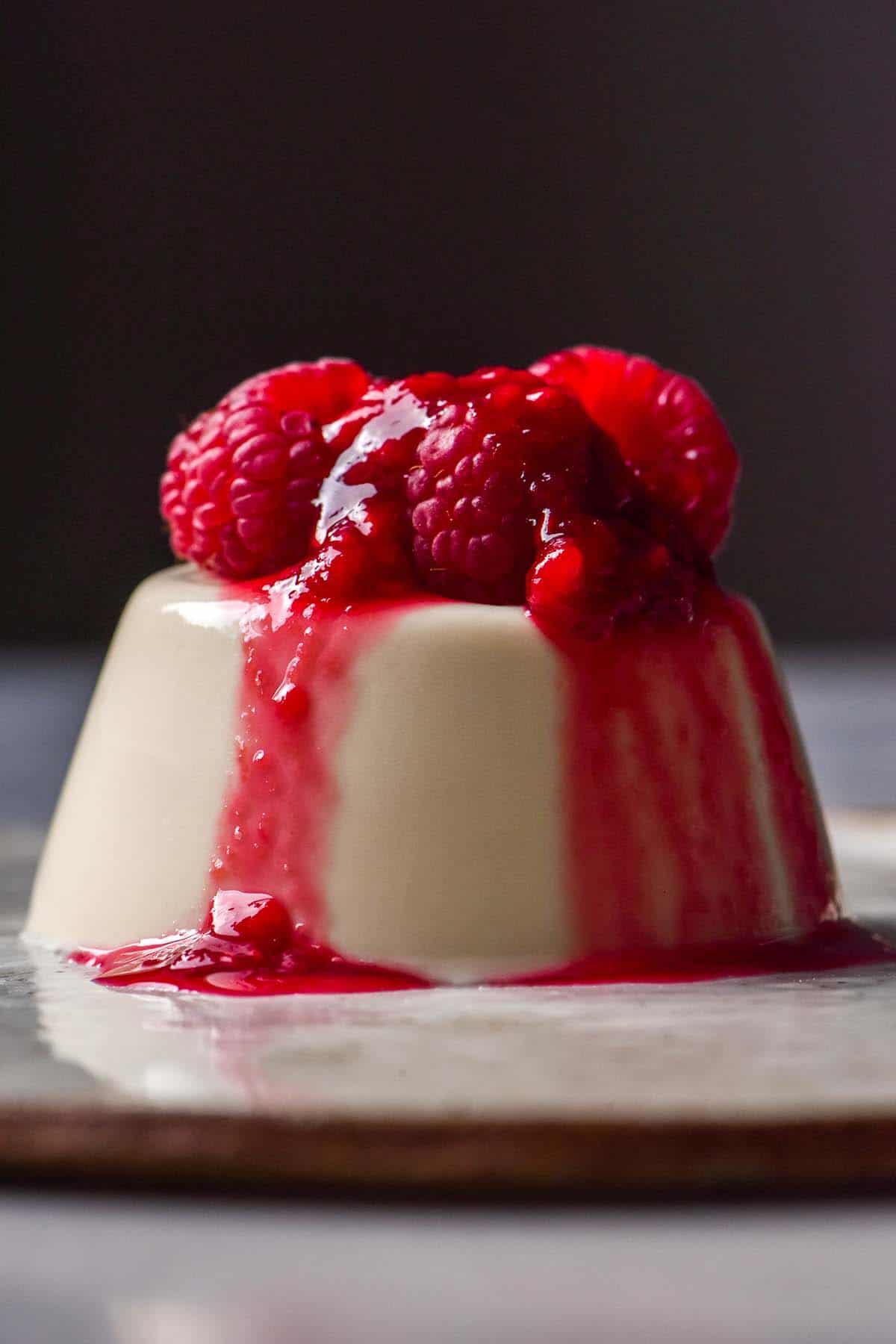
Tips and ingredient notes for your vegan panna cotta without coconut
- I have only tested what is listed in the recipe card. I have not tested sugar alternatives or cream alternatives. If you would prefer to use coconut instead of vegan cream, see my recipe here.
- To dissolve the agar agar powder, I recommend whisking it into the sugar and then pouring over the water. Add the vegan cream last.
- Once your mixture has been whisked together, switch to using a silicon spatula. This helps keep the cream on the bottom of the pan from overcooking. More importantly, though, is that it doesn’t agitate the vegan cream. My experience with vegan cream is that it gets foamy very easily and this can result in panna cotta with bubbly bases (or create the need to skim foam off the mixture).
- I find that vegan panna cotta tend to have a slightly tough skin on the base when they set. If you can, either cover the bases of your panna cotta with cling film to prevent them forming a skin, or allow them to cool and put them in an airtight container to set in the fridge.
- Vanilla and a pinch of salt go a long way to disguising the subtle vegan cream taste. I highly recommend using them.
- Something else that really disguises this is a good berry coulis. I like a raspberry one, but anything goes.
More vegan dessert recipes
- Gluten free vegan cinnamon rolls without yeast
- Vegan vanilla Ninja Creami ice cream
- Gluten free vegan banana muffins
- Gluten free vegan sticky toffee pudding
- Gluten free vegan vanilla mug cake
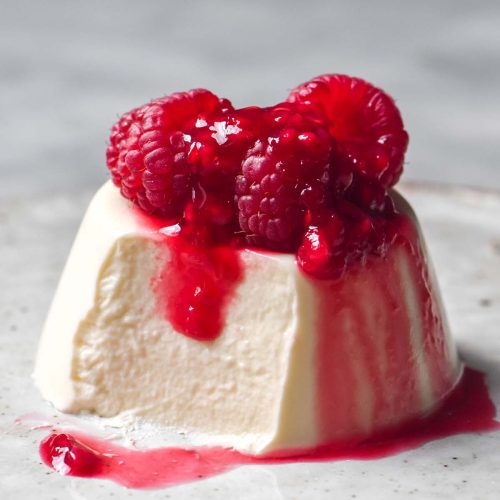
Vegan panna cotta without coconut
Equipment
- 8-9 X 80ml (1/3 cup) silicon muffin tin holes or moulds of a similar size
Ingredients
- 3 g agar agar powder (not flakes, see notes in the body of the post)
- 50-75 g caster sugar, according to your tastes
- 250 g water
- 500 g Flora Plant Cream (see notes in the body of the post)
- 2 teaspoons vanilla extract or vanilla bean paste
- Pinch of fine salt
Instructions
- Whisk the agar agar powder and sugar together in a mixing bowl. Pour into a medium size sturdy pot and whisk in the water.
- Whisk in the plant cream until combined, then switch to a silicon spatula. The vegan cream becomes foamy quickly and we don't want that for the panna cotta.
- Place the pot over the smallest burner on a low heat. Allow the mixture to cook, stirring intermittently, for 10-15 minutes. If it hasn't come to a simmer after this point, turn the heat up just slightly. Cooking agar agar on a low and slow heat is key to getting the perfect set panna cotta the first time around, so don't rush it.
- If the mixture hasn't come to a simmer after 20 minutes, turn the heat up again. Once bubbles start to appear on the surface, continue to cook for about 3-5 more minutes, stirring frequently. Add the vanilla and salt while you wait and stir to combine.
- Pour the mixture into a large jug with a pouring lip – this makes it much easier to divide into your moulds. I use 80ml silicon muffin holes and it makes 8-9 panna cotta.
- Pour the mixture into the moulds and allow it to cool before transferring to the fridge. To avoid a hardened base on your panna cotta, I recommend placing fully cooled panna cotta in a large airtight container. You can also lay cling film flush up against the base of each panna cotta, but this can get a bit finicky if you are using a silicon muffin tray.
- Allow the cooled panna cotta to set for at least 3 hours or up to overnight. I like to make them the night before to correct any errors if they arise. If your panna cotta haven't set after 3-4 hours, you have not cooked the mixture long enough to gel it. The good news? You can decant the mixture back into the pot and cook it again to ensure it sets.
Notes
- I have only tested this recipe with the ingredients outlined in the post.
- Read the body of the post for extensive notes on the Flora plant cream (as well as international equivalents) and the agar agar.
- See notes in the body of the post for tips on working with agar agar.

No Comments